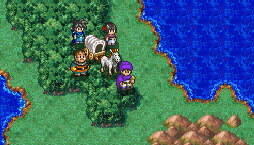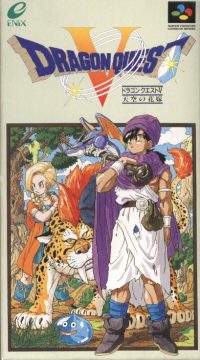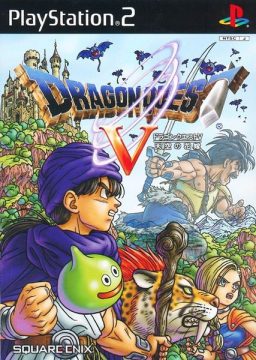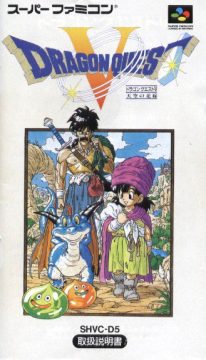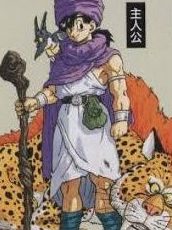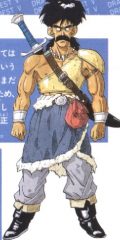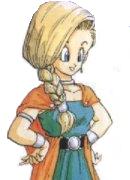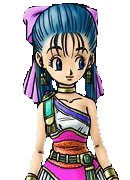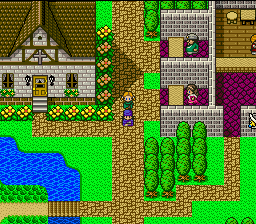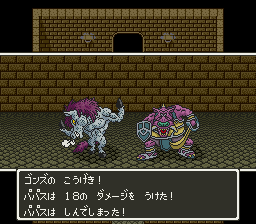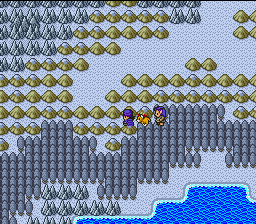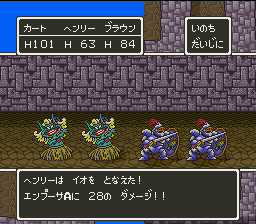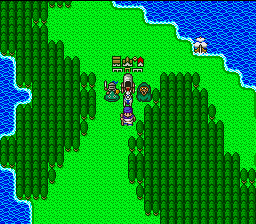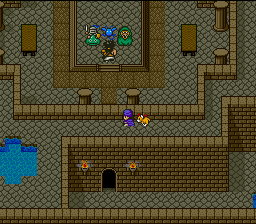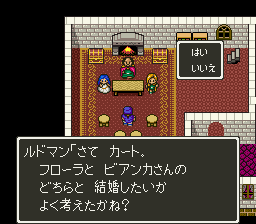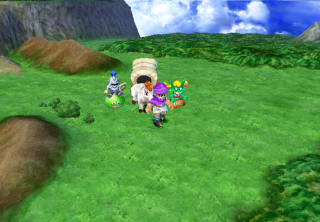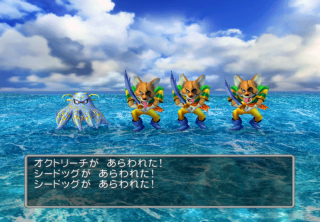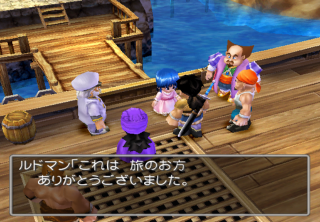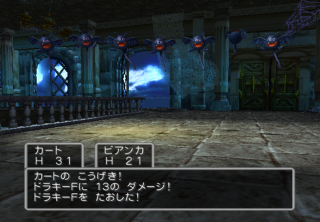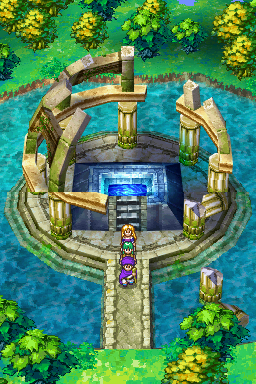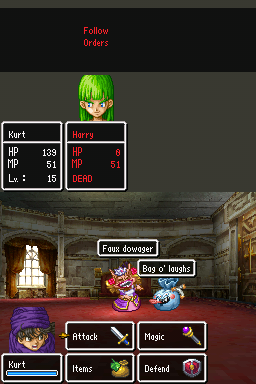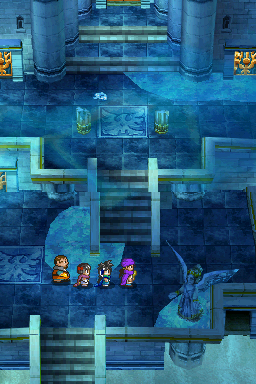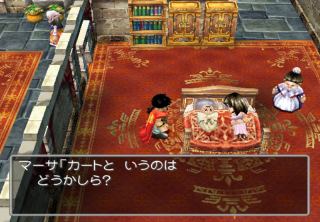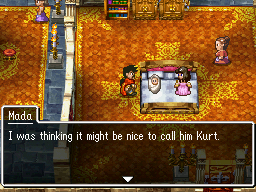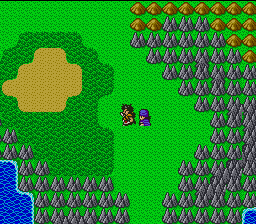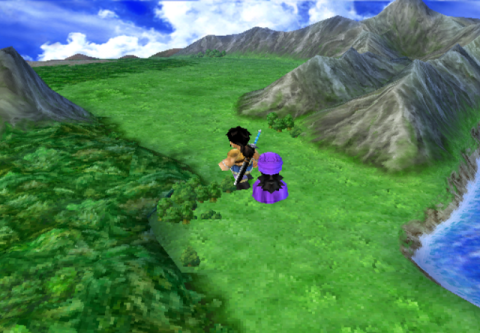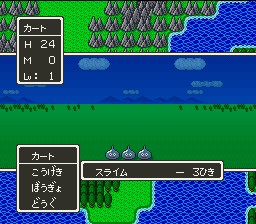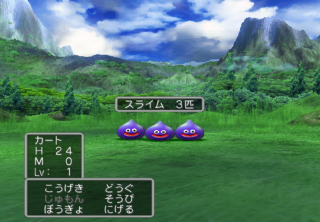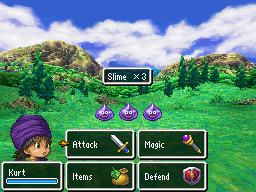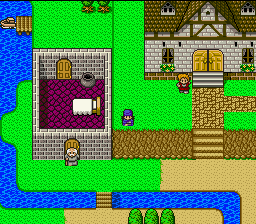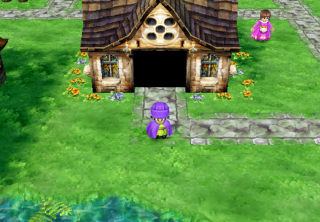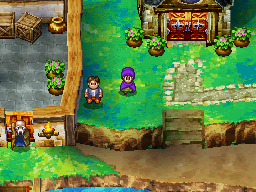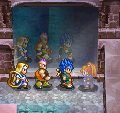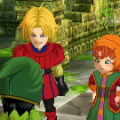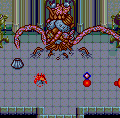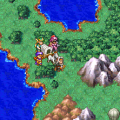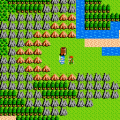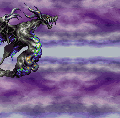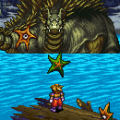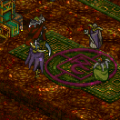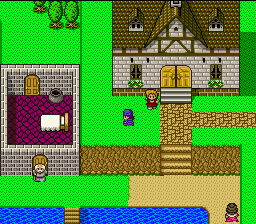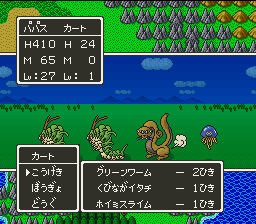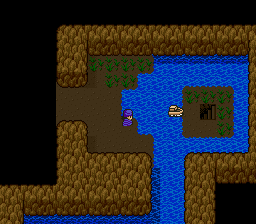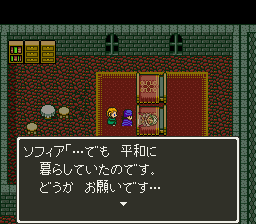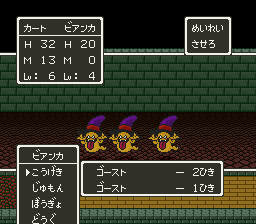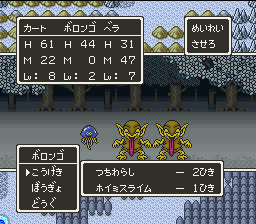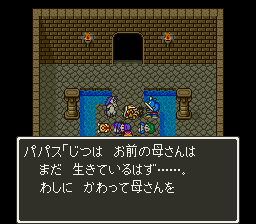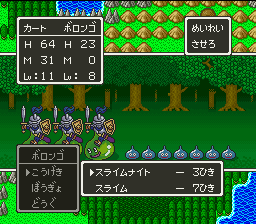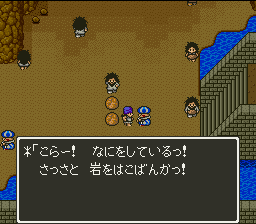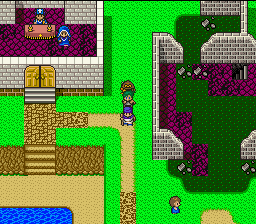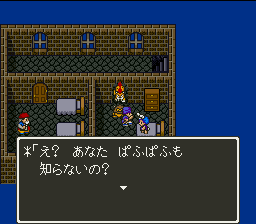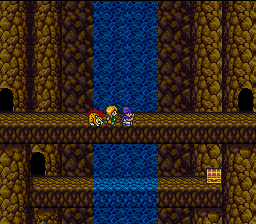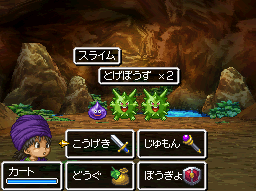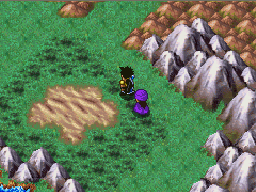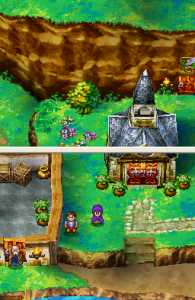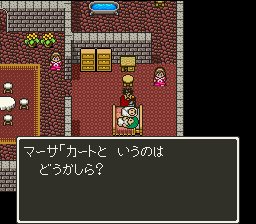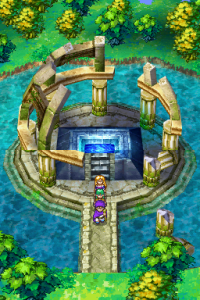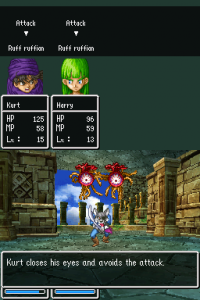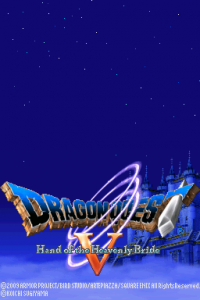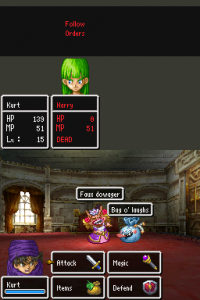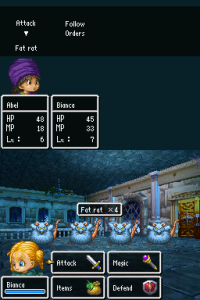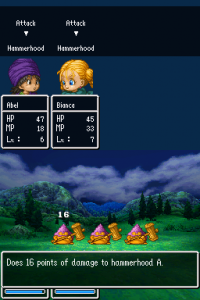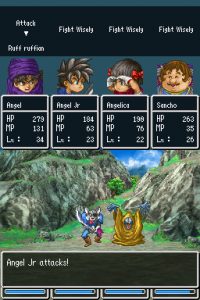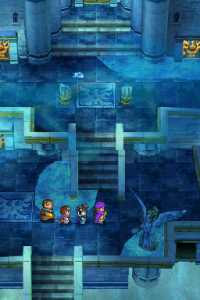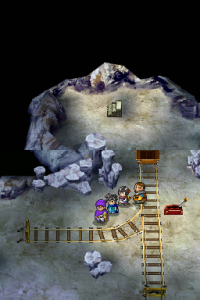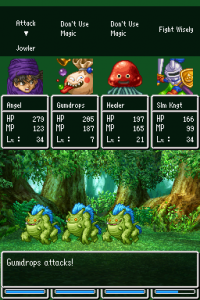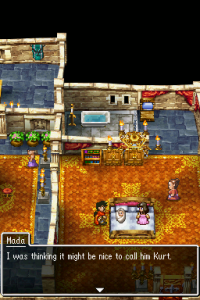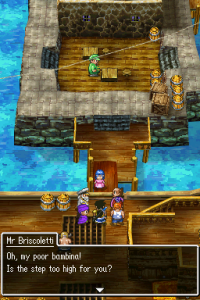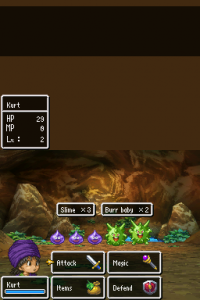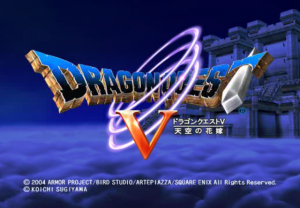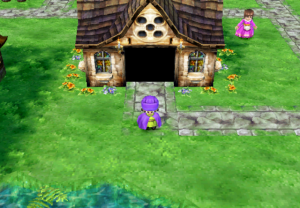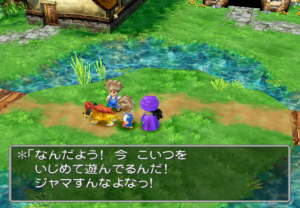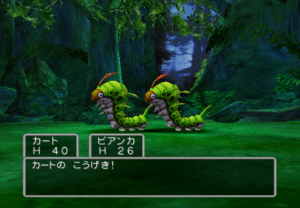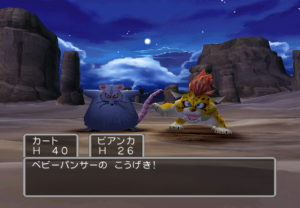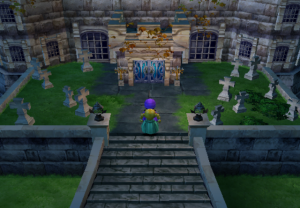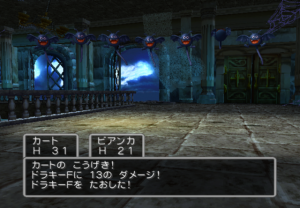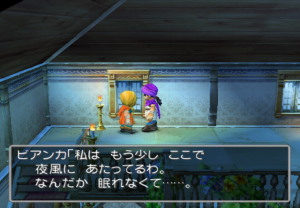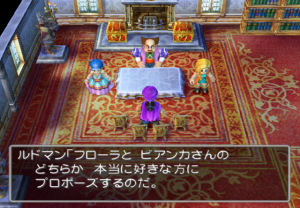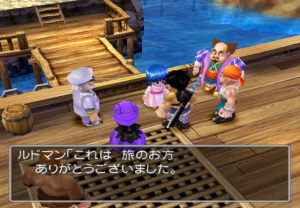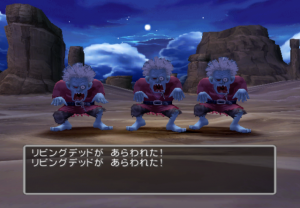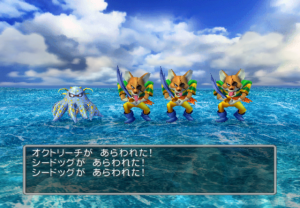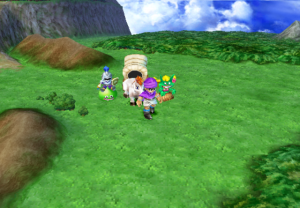- Dragon Quest (Introduction)
- Dragon Quest
- Dragon Quest II
- Dragon Quest III
- Dragon Quest IV: The Chapters of the Chosen
- Dragon Quest V: Hand of the Heavenly Bride
- Dragon Quest VI: Realms of Revelation
- Dragon Quest VII: Fragments of the Forgotten Past
- Dragon Warrior VIII: Journey of the Cursed King
- Dragon Quest XI: Echoes of an Elusive Age
- Slime Mori Mori Dragon Quest
- Dragon Quest Heroes: Rocket Slime
- Slime Mori Mori Dragon Quest 3
- Dragon Quest Heroes
- Dragon Quest Heroes II
Dragon Quest V: The Hand of the Heavenly Bride (subtitled Tenkuu no Hanayome in Japanese, which means “The Bride of the Sky”) is the first 16-bit installment in the series, released for the Super Famicom, and the second of the Zenithian trilogy. Much like Final Fantasy IV and V, it keeps much of the graphical style of the 8-bit games, but adds more color and detail to the graphics. But Dragon Quest V strengths go far beyond the presentation – it’s really about unique storytelling, as it follows on the different stages of the hero’s life, from the moment he’s born, up through his childhood, until when he raises a family of his own, all while having plenty of daring adventures.
Characters
Hero
You’re just a precious little kid at the beginning of the game, adventuring with your dad. Eventually you grow up and become a powerful beast tamer. His official name is either Abel, if you go by the official instruction manual or PR screenshots, or Ryuka, according to the manga.
Pankraz / Papas
Your loving father, former king of Gotha, who mourns the loss of his dear wife Martha. Just as you’re getting pummeled by those slimes at the beginning, he steps in, heals you, wipes the floor with the attackers, and saves you from certain death. His motives are a bit mysterious, until he confesses the secret he’s hiding.
Bianca
The young daughter of one of the villagers, you first meet Bianca as a child, and the two of you rapscallions sneak outside at night to have some crazy adventurers in a nearby haunted castle. Later, she becomes one of the girls you can marry. For some reason, the SFC manual refers to her as “The Mysterious Girl”. Basically looks like a kinder, gentler version of Android 18 from Dragon Ball Z with long braids. She’s skilled in offensive magic. Your kids will be blond if you marry her.
Nera / Flora
Flora is the other girl you can marry, who’s a bit more quiet and reserved than Bianca. She’s also generally less interesting, considering you don’t meet her until later in the game…at least, in the Super Famicom version. The game heavily tilts the favor towards Bianca, actually – Flora isn’t even mentioned in the manual. However, since she’s the daughter of a rich guy, you get lots of bonuses from him, so it’s almost easier to choose her. She’s skilled in defensive and curative magic. If you marry her, your kids will have blue hair.
Debora
This new girl, added to the DS version, is on the feisty and spoiled side, almost comically so. Debora actually treats the hero as something more of a servant than a husband. She’s actually Nera’s older sister, despite being almost the opposite of her. She has strong offensive skills, both physical and magical. If you marry her, your kids will have black hair.
Dragon Quest V begins as our hero is born to Pankraz and Martha, a proud young couple. As they decide on a name, Martha falls silent, with only the baby’s cry breaking the silence. Fast forward a few years, as you, the hero – just a kid at this point – and his father are adventuring together. It’s a pretty cool feeling when you first step on the overhead and immediately get creamed by some slimes, only to have Pankraz jump in, give the monsters a good ass-kicking, and save your hide. Although you’re just a few years old and can barely read, you still find some time for adventuring, and eventually adopt a little panther cub. During these adventures, you learns that your mother passed away giving birth, and your father still grieves to this day. At this point, Pankraz takes on a job as a bodyguard for Henry, the spoiled prince of Coburg.
Your journey is cut short, however, when you and Pankraz are ambushed by some evil foes. As you’re knocked to the ground, you watch helplessly as Pankraz tries valiantly to protect you – and falls in combat. The action freezes as the reality of situation hits you.
Gonz’s attack!
Papas received 18 HP of damage!
Papas has died!
Before being burnt to death by your captors, Pankraz confesses to our hero that his mother is still alive, and begs for you to find her. You and Henry are imprisoned in a slave labor camp for ten long years, during which you mature from a small little boy into a young man. After much hardship, you escape to freedom, in hopes of finding your lost mother and carrying out your dying father’s request. Along the way, you’ll learn of Pankraz’s true quest – to find the Zenithian Hero, the one who can enter the Demon World and save the land from chaos. In a bit of a shocking twist, you’re not the prophesized hero – but you spend the rest of the game trying to find them, in addition to tracking down your mother.
Along the way, you’ll learn stories of your parent’s courtship, which is pretty cute. At one point, you’ll get to choose a bride of your own to marry, have kids, and eventually reclaim your father’s role as king. After further adventuring, you and your wife are actually captured and encased in stone – only to be rescued several years later by your children, now fully grown heroes in their own right. And you soon learn that your kids may have an important fate cut out for them as well.
The hero is unique beyond just his place in the story. Rather than being a strong warrior, he’s a healer and a monster tamer, a far cry from the typical swordsman found in other RPGs. Due of the hardships he endures over the course of the game, he’s also jokingly referred to by Japanese fans as “the most tragic hero of the series”. His quest is a little different too, since there’s no great demon to defeat, at least at the beginning.
The earlier Dragon Quest games are often derided for their straightforward scenarios, but Dragon Quest V is one of the most involving – and emotional – of almost any RPG out there. There really hasn’t been any other game that follows this format – Sega’s Phantasy Star III is about as closest as you can get, but neither the plot nor the characterizations are nearly as fleshed out as they are here. Dragon Quest V doesn’t offer as many options though – the girl you choose to marry only slightly affects the plot, and your children will have the same stats regardless of who your marry as it only changes their hair color. But the focus on a single character works much better here, feeling like the equivalent of an epic poem, that tells the story of three generations of heroes.
Dragon Quest V also introduces monster taming. As soon as you reach adulthood and purchase a wagon, you can draft enemy monsters to fight in party. There’s no trick to it – just have an open spot in your party lineup, and certain monsters will offer to join after battle, if you’re strong enough. Each has their own unique name (you can meet another Healslime named Hoimin, like Dragon Quest IV) and also level up and gain new abilities as they can experience, just like regular party members. There are a total of forty-two monsters to play as in the Super Famicom version, which is pretty sizable, and this is in addition to all of the other human characters that you can play as (your wife, your kids, and various others.) This system would eventually serve as the basis from the Dragon Quest Monsters spinoff, which was primarily created due to the popularity of Nintendo’s Pokémon series. One of the first creatures you recruit is Saber (named Borongo in Japanese), a young sabretooth cat, who later rejoins the hero when they are both fully grown…after you tame him, anyway.
This isn’t without its downsides – you can only take three characters into battle at once, at least in the initial SFC version, which is a significant downgrade from the previous two games. At least the party AI is much better than Dragon Quest IV, and you can control all of your party members manually, at least once you’ve built their intelligence stats up. Additionally, certain weapons, like boomerangs and sickles, can now attack groups of enemies, which makes battles go by much quicker. Technically a boomerang was introduced in the previous game, but they’ve become standard here (and the remakes of Dragon Quest IV removed it anyway). A few other new things have been added, like a slime race in the casino, in addition to the usual slot machines and monster arenas. There’s a seperate Fairy realm to explore, with its own (relatively small map), plus this is the first Dragon Quest game to introduce a bonus, post-game dungeon.
The visuals are an improvement over the original, although it still looks a bit drab, and it lacks any fancy Mode 7 effects. The sound chip of the SNES also allows for high quality instrument samples that sound close to a real orchestra. Some of the music sounds flat compared to later SFC titles, but considering this was released early in the system’s life cycle, it’s actually pretty impressive. The movement is still clunky, but a bit smoother, and there’s now a context sensitive “examine” button (either shoulder button) which will automatically talk to people, open doors, look at objects, and such. It’s definitely a step up from the Famicom games, but overall it still feels pretty primitive.
At this point, in 1992, Enix has all but given up with RPGs in America, so despite the popularity of Final Fantasy II (IV) on the SNES, it was never officially translated. Despite its age, it’s often remembered as one of the best of the series, and is acknowledged as Yuji Horii’s favorite.
Dragon Quest V was later remade for the PlayStation 2 in Japan in 2004, developed by Arte Piazza and Matrix Software. All of the graphics – characters, monsters, landscapes – are rendered in polygons, although it’s hardly all that fancy looking. The game utilizes a similar overhead camera, so it never zooms too close to show how shoddy the character models are. Some of the maps and dungeons have been redesigned to take this into account. And despite feeling pretty low budget, it’s not particularly ugly, just very simplistic. The interface has been much improved – doors open automatically, you have access to the Bag and the monster book from the later games, and the hero walks significantly faster. Most of the music is from a live orchestra, recorded by the NHK Symphony Orchestra for an album release back in 1992, but there are a few extra songs, plus the ones that weren’t recorded previously are created with a synthesizer. It all sounds fantastic, and was the first Dragon Quest released in Japan to feature real orchestral music.
The battle roster has also been expanded allow four characters, and drastically expands the number of recruitable monsters, from 42 to 70. As a result, the monster strengths and overall difficulty have been rebalanced to suit the extra party members, and you can fight more monsters at once in battle. The monster animations in battle are pretty cool – it’s fun to watch the slimes fling themselves right into the TV screen as they attack.
The scenario itself is almost exactly the same as the Super Famicom version, although this time you meet Flora as a child at the beginning of the game. This was an attempt to make you feel more attached to her when it comes time to choose a bride, but it’s still weighted heavily in Bianca’s favor. A few other scenes have been added throughout too. A Sugoroku game has been added, similar to the one from Dragon Quest III for the Game Boy Color. There’s also some special new regional equipment that come across, which can be displayed at a special museum.
Compared to Dragon Quest VIII – which came out a few months after this – this remake looks rather dull, and it’s undoubtedly why Square-Enix skipped on localizing it for the rest of the world – but it’s preferable to the Super Famicom version. An English fan translation was released in 2010.
Dragon Quest V was also released for the Nintendo DS, in 2008 in Japan, and in 2009 worldwide, featuring the subtitle “Hand of the Heavenly Bride”. Using the same engine as the DS version of Dragon Quest IV, it features the same enhancements, like fully animated enemies, although many of the assets are the same. Feature-wise, it’s a mix between the SFC and PS2 versions – it includes the four party battles and additional monsters (there are even two new ones) but ditches some of the rendered movies in favor of the original SFC cutscenes, and changed a couple of the dungeons – the Forest of Illusion is back to its SFC version, and the Heaven Tower is just a ruined version of the one featured in Dragon Quest IV. Like Dragon Quest IV for the DS, the environments are more tightly packed, and the battle system is blazingly fast. The music is a midpoint between the two – obviously not as good as the live orchestrations from the PS2 version, but better than the SFC version. Most important is the addition of Deborah, allowing for three different brides. Like Flora, she shows up briefly on the boat at the beginning of the game, but still doesn’t take a great role unless you decide to marry her. There’s also a few new pieces of equipment for her. There’s also another new minigame that uses the touchscreen called Slime Touch.
Even more importantly, this is the first time that Dragon Quest V was released in English. It follows the translation style of the DS remake of IV. The accents aren’t quite as overdone, though there is a backwoods that has a very “rural” way of speaking. Some of the names were changed from the Japanese versions, like Papas to Pankraz and Flora to Nera. This was also used as the basis for the Android and iOS ports.
Screenshot Comparisons
The Hero’s Birth
Overworld
Battle
Town
